 I love hearing stories about how shortwave radio listeners and ham radio operators got interested in the hobby. I’ll tell you about my experience, but I would enjoy hearing yours either in the comments section or by sending me an email. In the coming months, I will select stories to feature on The SWLing Post––especially if you have photos!
I love hearing stories about how shortwave radio listeners and ham radio operators got interested in the hobby. I’ll tell you about my experience, but I would enjoy hearing yours either in the comments section or by sending me an email. In the coming months, I will select stories to feature on The SWLing Post––especially if you have photos!
As I started to write a little of my personal history in radio, I felt a sense of déjà vu. That’s because in May 2011, Monitoring Times Magazine asked if I would write a piece describing how I became an SWLer and ham radio operator; of course this made for a nice segue into how I started the charity, Ears To Our World. After a little digging, I have discovered the unedited piece and added/updated where necessary.
So here’s my story–(now please share yours)!
[Update: Click here to read our growing collection.]
A Love of Listening: How I Relate to Radio
Growing up, listening…
I’ve never been a fan of television. Ironic, considering that I grew up in the seventies and eighties when most kids were glued to the tube, addicted to Nickelodeon. Perhaps one of the reasons why is that I find the visual often distracts from what I want to hear. Maybe it says something about my reluctance (or inability?) to multitask, but I’m much better at simply listening, rather than listening while also being asked to watch. I prefer to close my eyes, to just listen––and allow my mind to construct images from sound.
When people ask how I became so interested in radio, the answer comes clear: I just love to listen. My father still has, in his living room, the vintage RCA 6K3 wooden console radio which emitted, like an aging, crackly-voiced Siren with her own kind of coarse charm, the various scintillating sounds that first caught my ear and captured my young imagination.
One of my earliest memories is of my father, tuning in WWV in Fort Collins, Colorado, on the RCA to set his watch to the atomic pulse coming through the aether, a practice he followed each Sunday morning. Sometimes he would allow me to tune around afterwards––on these occasions, I would catch broadcasts out of Europe, Australia, South America, as well as places I could not readily identify.
Not long after, my great aunt unearthed in her basement a classic Zenith Transoceanic, which she offered me; I took the dusty unit into my room and promptly set up a listening post. Little did I know at the time that I was joining a fraternity of radio listeners around the world who also logged and listened to stations, as I began to do, far into the night. I often fell fast asleep listening to my Zenith; no doubt, some of those mysterious DX stations I heard over shortwave and medium-wave infiltrated my dreams with languages and cultures altogether unlike my white-bread American one.
Then when I was in my teens––again, in an ironic twist––a TV repair man who came to work on my parents’ set mentioned that he was a ham, and I was suddenly introduced to the intriguing world of ham radio. Though it took several years before I pursued my ticket, as I was busy with school, music, and other typical teen pursuits, my interest in the medium deepened.
While doing my undergraduate degree, I spent a year living and studying in France. At the time, the world wide web was still in its infancy, and my portable shortwave radio, which had helped teach me French back home, now became my English-speaking companion, bringing news from home courtesy of Voice of America. Unlike satellite television, cable TV, or an internet connection, radio was also inexpensive, vital for a poor student like me struggling to pay my own way in Europe. Through just listening, a virtual sonic flight home was free and nearly instant, arriving at the speed of light.
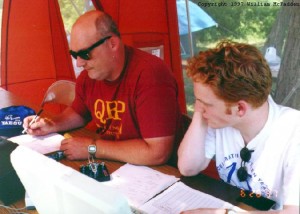
Mike Hansgen (K8RAT) teaching me the ropes at my first QRP Field Day in 1997. William McFadden was also there and was photographer for this photo. (Source: William McFadden WD8RIF)
After graduation, once more stateside, I encountered two hams who were to become lasting friends and elmers: Mike Hansgen (K8RAT) and Eric McFadden (WD8RIF). These two talented hams nourished my keen interest in the hobby, and in their company, I soon found myself in the field experiencing the scrappy fun of hands-on radio contests. I loved how my resourceful guides worked so many stations with the lowest-powered QRP equipment and only the simplest, cheapest wire antennas, and moreover, that they often derived their station power from the sun. I appreciated the remarkable skill with which they milked such modest equipment, initiating contacts all over the globe. With their steady encouragement, I finally got my ticket.
I’ve been a ham since 1997. Radio, no doubt, has influenced my decisions to travel, to live and work abroad, to pursue a graduate degree in Social Anthropology at the London School of Economics. Whatever I did, I did while listening to radio. I even changed my call not long ago to reflect my passion as a shortwave radio listener; my new handle is K4SWL.
Recently I found myself charmed and inspired by a BBC audio piece on Gerry Wells, the British radio repairman who in his eighties continues to do what he has always done, and is still sought for his skill. The story’s subject is truly enjoyable, if a bit of an anachronism: most remarkable is its relevance in the new millennium due to the simple fact that old mid-century (and earlier) radios continue to function today, and are still relied upon by listeners. As I listened to this report, I couldn’t help but wonder, as I have so often before: why does radio have such powerful nostalgic appeal? I reckon that, at least in part, it’s because radio has always been the voice of reassurance, of comfort, during darker times, reminding us that we are human, yet reminding us of our ability to survive. Radio is a friend––or, perhaps, a “great-uncle, in cords and a cardigan,” as Jeremy Paxman characterizes the BBC in his recent defense of this valuable institution in The Guardian––whose warm, familiar voice is there even when other media sources, or the internet, are down.
Shortwave, meanwhile, is much like the world’s pulse––we check in, we listen, and we confirm: all’s well, we’re still okay.
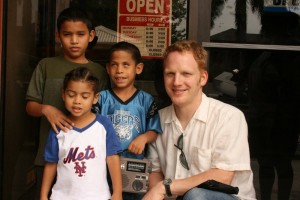
In this photo from Belize, I’m working with David (blue shirt), who is visually impaired–radio opens a world for him.
Listening as mission
One could say that listening to radio has shaped my life. I suppose that’s why radio has recently become a mission for me. Today, I’m the founder and director of Ears To Our World (ETOW), a charitable organization with a simple objective: distributing self-powered world band radios and other appropriate technologies to schools and communities in the developing world, so that kids like I once was, not to mention those who teach them, can learn about their world, too, through the simple act of listening. I want others––children and young people, especially––who lack reliable access to information, to have the world of radio within their reach.
Specifically, Ears to Our World works in rural, impoverished, and sometimes war-torn or disaster-ravaged parts of the world, places that lack reliable access to electricity (let alone the internet) and where radio is often the only link to the world outside. The heart of our mission is to allow radio to be used as a tool for education, so we give radios to teachers, who, in turn, use the radios in the classroom and at home to provide real-life, up-to-date feedback about the world around them.
Through the encouragement of our good friends at Universal Radio and the extraordinary magnanimity of Eton corporation, who donate our wind-up world band radios, in our first two years and on a budget of less than $3500, ETOW managed to distribute radios to schools and communities in nine countries on three continents––in Africa, Eastern Europe, Central and South America, and the Caribbean––as well as to both Haiti and Chile, where the dissemination of information through radio was life-saving when earthquakes struck.
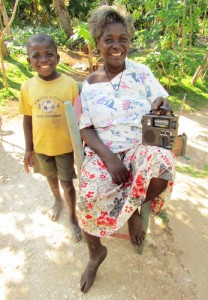
Post-earthquake, ETOW radios continue to be a vital link for those in need in Haiti. Here, Erlande, who suffered a stroke in her early 30s and can barely walk, listens to one of our self-powered Etón radios, given to her by ETOW through their partner, the Haitian Health Foundation.
We’ve done all this through partnerships––with other reputable established non-profit agencies like us––that already help struggling schools throughout the world, and who believe, as we do, in freedom of and access to information. Creating these partnerships is an important move: due to the very nature of the remote regions we serve, extending our assistance demands persistence, financial resources, and logistical support, times ten. And often a great deal of patience. Just shipping radios to other countries usually involves detailed arrangements with national and regional governmental authorities (for example, to waive duties or taxes); once the radios arrive, safely distributing them to these remote areas can also be very costly and complex. We listen attentively to our existing partner organizations, who have often laid the groundwork in these regions, and have established reliable connections with communities in them. Their need is for resources—like radios.
By listening closely to and working cooperatively with other established organizations, we find we’re able to distribute radios much more cost-effectively, too. In other words, we can operate on a shoestring budget so that donations to ETOW are used wisely and to their fullest extent. For example, because of our strong partnerships, money otherwise spent on travel can be put into shipping costs instead, thus getting more radios to more of the world with less donated funds.
So far, our scope has been limited only by our financial resources. Meanwhile, we are looking to place radios in other countries farther off the beaten path; Mongolia recently received our radios. Yet we’re not simply focusing on expansion: ETOW is establishing strong, lasting bonds with our schools and teachers so as to better serve their needs long term. We endeavor to replace their equipment and batteries as needed. We would also like to develop on-air teacher training programs; a new partnership with Oklahoma State University seeks to develop and disseminate content on important subjects, among them literacy and health education, so there is new and valuable content to listen to.
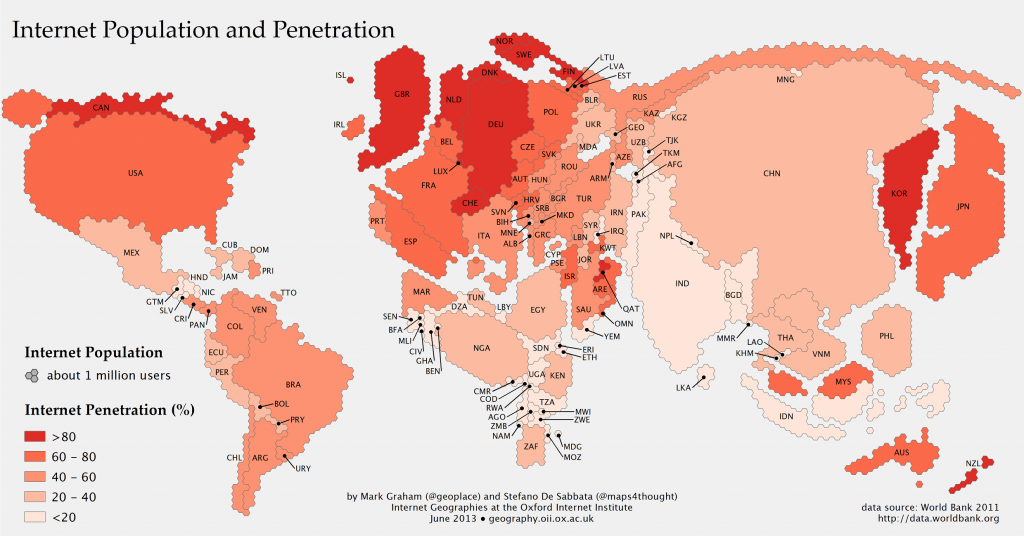
June 2013: This map shows the world adjusted for each country’s Internet population. Click to expand (Source: Information Geographies project at the Oxford Internet Institute)
MT readers [and especially SWLing Post readers] will have already guessed why we prefer radio to, say, computers, for information access. It is because much of the world does not have the communications infrastructure to support access to the world wide web and other dynamic media sources such as digital television, wireless networks or even electric power or phone. [Simply take a quick glance at the map above which shows the world adjusted for each country’s Internet population; notice how central Africa is all but missing?] Political instability, meanwhile, can undermine even the written word [for examples, check out our tag category: why shortwave radio?].
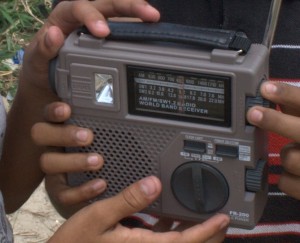 Radio, however, is simplicity itself: all one needs is a modest yet capable receiver, and one has instant––speed of light––access to local and world media. So far, every teacher we’ve worked with already knows something about radio; indeed, many of them have an intricate knowledge of broadcast schedules. But in these places it can take up to an entire week’s wages to pay for a set of batteries. Thus ETOW’s wind-up radios become vital–we effectively eliminate this cost, giving them steady access to information.
Radio, however, is simplicity itself: all one needs is a modest yet capable receiver, and one has instant––speed of light––access to local and world media. So far, every teacher we’ve worked with already knows something about radio; indeed, many of them have an intricate knowledge of broadcast schedules. But in these places it can take up to an entire week’s wages to pay for a set of batteries. Thus ETOW’s wind-up radios become vital–we effectively eliminate this cost, giving them steady access to information.
And the reports we’re hearing from the field have been overwhelmingly encouraging: Teachers in rural Mongolia, Tanzania, and Kenya are able to teach current events. Visually impaired children in rural Belize can listen to the outside world and hear music and languages they’ve never heard. Children in Haiti and families in Chile learned where to go to get food and medical care and information about loved ones affected by the quakes. A remote community in southern Sudan was able to listen to reports of their burgeoning country’s first democratic election. Being able to listen is making a difference.
Listening and learning work together
Radio captured my imagination as TV never could, it travelled with me and taught me early on that everyone has a story. Listening to radio taught me, too, that each voice is different in the consideration of what’s meaningful or newsworthy. I learned to understand––or at least appreciate––the diverse perspectives I heard in my vicarious radio journeys, and from these sprang my own opinions, hopes, beliefs. Radio became my teacher, one who gave me, in my formative years, a global perspective.
Just as radio taught me, and opened my young mind, I’m convinced that it can teach and open the minds of others. In some parts of our world, futures are still written on the airwaves. But it’s never just a one-way street–willingness to listen to those with whom we work helps us better serve them, but also to make the leaps of mind required to cross cultures, to become aware of those outside our Western sphere, to understand and grow and learn, ourselves.
Listen and learn. That’s ETOW’s tag line, but to some young people––and to me––it still means the world.
•••••••••••••••••••••••••••
Want to help us give the gift of radio? Visit ETOW online at earstoourworld.org or write us at Ears To Our World, PO Box 2, Swannanoa, NC 28778, USA.
Your personal interest, or that of your local radio club or business, could put radios in a school or village in the most remote corner of the world.

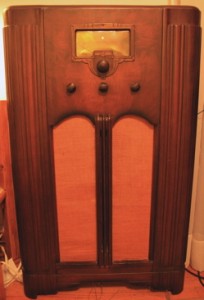
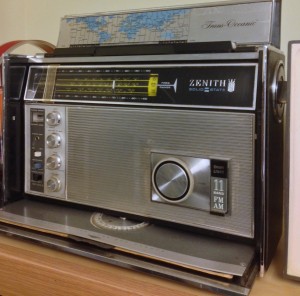
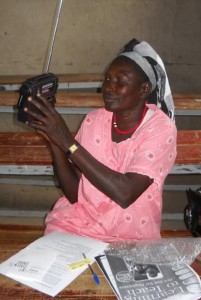
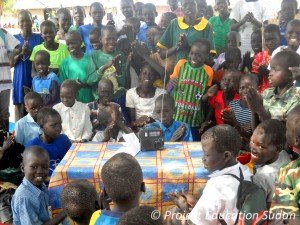
I could leave a comment, however, I wrote a book about not only how I got started, but including over 300 artifacts from radio stations in nearly 200 countries worldwide on all 7 continents – these are cards and letters that I received over nearly 60 years of listening. Some of these were obtained after some interesting relationships with station staff that are recounted in the book. Along with the card and letters, I added some geographical and historical notes about many stations and several maps to illustrate where these stations are. The latter was geared to prospective hobbyists who are geographically-challenged. The book is entitled “Radio’s Global Voice: A Radio Journey Across 7 Continents” and is available on Amazon in both softcover and on Kindle. If you would like a softcover review copy, all I would need is your mailing address for Amazon shipping. Thanks for an interesting blog on shortwave topics!
Dear Thomas,
The Tecsun PL-680 is still available on ebay & anon-co. Is the radio still being produced by Tecsun or are these refurbished units on sale. I am asking because there is more discussion on PL-660 & 880 during reviews and on sale on other web sites but not much on PL-680.
Also PL-680 is available cheaper on anon-co website than ebay. Is it okay to purchase from anon-co website directly.
I am interested in Tecsun PL-680 as I have read in reviews that it has all the pros of 660 and the speaker is better than 660.
Please advise
Warm Regards,
N R Shenai
I have a Tecsun PL880. It came with a user’s manual The manual is not very detailed. It does not enable me to use all the features of the radio. Not being a whiz on this stuff, I’d like to find detailed instructions on how to use the radio. I have the hidden features material (from the web) but I’d like instructions on using the basic stuff, which the manual really doesn’t help me much.
Your swling site is very informative.
Thank you,
Paul
March/April 1969, when I was 9 years old. I as so young that I’m not completely sure of the sequence, but I think it was that article in that issue of “The Canadian Boy” (a magazine for Scouting in Canada) that had an article about DXing the AM broadcast Band. I know that date because someone put the issues online and I went looking. Maybe I saw an article about amateur radio in “Jack & Jill” around that time, but I don’t know. I’m sure I didn’t realize there wa a shortwave band on the old rdio in the living room, until I read the article.
More important, there were some followup letters, and something about amateur radio, and for some reason, that caught my fancy. I can’t remember why. So it was pretty much from that point that I was going to get a ham license, except, at the time you had to be 15 or older in Canada. So over five yeas to wait.
The next year I worked through the “electronic” books in the children’s library (really mostly about electrical projects, like cooking hot dogs with two nails plugged into the wall) and then got access to teh books in the adult library. But I also got a telegraph set (an actual sounder, but it also displayed with a light bulb or a buzzer), in anticipation of the code requirement for the ham license. Not a useful thing, you need to receive before you can send.
IN January of 1971, I found the hobby electronic magazines on the newsstand. Those at the time covered a broad spectrum, CB, SWLing, amateur radio and all the projects. I couldn’t understand most of it at first, but I kept at it and picked up what was going on. That was the era when “Communication World” was put out as a quarterly by the same publisher as Elementary Electronics, and “Communication World” another quarterly, put out by Ziff-Davis, which published Popular Electronics. The former carried WHite’s Radio log, the latter was mostly an equipment roundup, with some articles, covering SWL, CB, scanners and amateur radio.
I was actually getting QST by April of 1971, another very foreign magazine that became familiar with time.
I didn’t get a shortwave receiver until July of 1971, a Hallicrafters S-120A (the solid state model), using up my accuulated birthday and Christmas money. It was the lowest priced receiver I could get locally (at Etco Electronics in Montreal), but it was junk. It had all the bad of the low end tube receivers, plus the problems of cheap solid state receivers. But it was exotic, the slide rule dial and all the locations printed on that dial, including Antarctica. Even the manual made it seem so fascinating. The limitations son became obvious, I couldn’t even receive SSB until I giture dout to use a potentiometer between the antenna and the antenna terminals, to attenuate the signal so the BFO was strong enough. But at that point, the incoming signals were attenuated so much, I cold only receiver a few really stong signals. It was good that there were still some people using AM on the ham bands, every night in the same frequency talking endlessly about nothing important.
Then in December of 1971, there was a small thing int he paper saying the rule about having to be 15 or older to get a ham license was being removed. So I took the test in May (mostly because I’d picked up enough through osmosis) and passed all but the code receiving, and the test in Canada was so much more difficult at the time. I went back in June, at the end of grade 6, and passed the code test and got the license. I never had to use the S120A as a ham, I had the use for a decade of a Hammarlund SP-600. Not perfect, but nearly infinitely better than the S120A.
And while I maintain an interest in both, I’ve never been a good SWL listener or a good ham. My interests were in the technical aspects. I didn’t even have a shortwave receiver for some years, until I started finding them at garage sales about 2006. On the other hand, I have now a fairly good collection, bought cheap. I paid more for the fist one, A Grundig Satellite 500 ($40) than any of the rest, and I made a high offer for that first once since it was the first time I’d seen a sw receiver at a garage or rummage sale. They were all solid state, until the TMC GPR-90 in the summer of 2012, only $20.
I don’t think I’d pursue either hobby if I found out about them today. But I would argue that’s because I’m forty years older. Some of the intrigue was because at 9 years old, the world was stilla very unknown place. Antarctica was exotic because I barely knew about it. Some of the driving force was probably dated, but that’s what appealed to me at that age. I think there’s still something for the young, but not by trying to compare it to the internet, but by showing how its different. SWLing and ham radio were never mainstream (though in the past, they got better mainstream coverage, it’s been years since I saw a reference in the local paper to amateur radio), it’s about finding the ones that are interested. And that seems harder today, when there are fewer general outlets to lure people in with. It’s way easier to find out about something today, but only once you’ve heard of it. Who would think there is anything about listening to anything but local radio. or talking over long distances for hobby purposes? I was the token kid with a ham license in high school, I got some others interested, but they never passed the test. But they already knew about the hobby.
Michael
Thanks for sharing your story, Michael! I’m simply amazed at the number of SWLs who got their start on the Hallicrafters S-120. What a great first radio for many.
Cheers,
Thomas
Great stuff Thomas! I developed a love for electronic things in general at a very young age. My folks had a huge problem with me taking phonographs apart to try to figure out how they worked. I remember my older brother Lee, starting a log of AM radio stations that he could receive, and getting a Wards Airline multiband radio that received Shortwave. It was right about then (early 70’s) that I was given my first Shortwave radio. We had a family friend who lived nearby that had traveled the world. She referred to herself as The Baroness Charlotte Serneaux Gregori. She owned an import/export company in New York, and was an accomplished painter of abstract art. Her house was filled with things she had collected in her travels, and she found out that I was curious about Shortwave radio. She gave me a small National Panasonic AM/SW transistor radio. That hooked me.
My second radio also came from her. Another National Panasonic. I still have this one, but it is not functional anymore. I went through a series of radios, including some of the classics (Panasonic RF-2200, Sony 6500, Sony 2010, Sangean 803a). I owned some Ham Radio equipment for a time, hoping to get my license, but that didn’t happen till about 2 years ago.
Charlotte passed away when I was a teenager. I have a couple of her paintings in my possession, as well as that radio. I recently purchased a Bulova AM-SW transistor radio that reminded me of the original one she gave me. I am having it restored to its original glory, which I hope to also have done to the second one. That might be a bit more of a job though.
I think one of the most valuable things I got from radio listening was to get more than one view on world events. When something happened in the world, I would listen to the BBC, Radio Australia, Radio Canada, Radio Tirana (for comic relief mostly), and many others.
These days I’m a licensed Ham. I love experimenting, and playing with low-power equipment, and I’m thrilled with the way Ham radio has embraced my career in computers now with digital modes, SDR, and so much more. I have gotten back into building things. I have to think that being a SWL for 40 years before getting my Ham license gives me a different perspective on the world of Ham radio. With everything going on in that world for me, I still listen. I’m a little disappointed in the direction that Shortwave radio is heading, but there’s still something to hear, and multiple views and opinions to absorb. I miss the good old days, and wish I had some of todays technology back when there was more to hear. Can you imagine having a SDR in the early 80’s?
Great post as always Thomas, and great site!
Such a fun post and I’ve enjoyed reading the other comments as well. I started listening to shortwave when I was in my early teens in the 80’s. It was around the time that I started collecting old radio shows on cassette (from Metacom…) that my great aunt let me near her shortwave radio. She was quite attached to it and she would let me listen and explore when I came to visit. My family and I moved in with her as we were waiting for a house to be built and my aunt couldn’t pull me away from the radio. It was (and is) amazing to scroll through the dial and hear all the voices and sounds from around the world; some that I could understand and many others that sparked interest. Once we moved away I wasn’t able to get near a shortwave radio for many years. It was only a few months ago that I finally bought a new radio and haven’t missed a day listening since. I’m so happy to have found your blog. I’m learning so much and find it very inspiring. Keep up the great work !
Wow–we share much in common as it was my great aunt who also gave me the means for a first step into SWLing.
Thank you for sharing your story!
-Thomas
Very nice piece, Thomas. I started out much like you, listening to crackling signals in my teens with my multiband in the mid 1970s, and then became an international broadcaster in the 1990s (Radio Nacional de Venezuela English program director and VOA news stringer in the Caribbean), but that is another story. Still do a monthly stint on Radio Nacional de España, in Spanish, as a panelist for a news program on Radio 5 / Radio Exterior. It will always stay in the blood.
Wow, Marty, your life did develop around radio! Honored to have your story on the site!
-Thomas
My interest in shortwave radio started in the early 1960s, I bought a National Transistor Radio that had the shortwave radio bands on it, I got the radio so I could listen to the local AM stations Top 40 Hits but that changed when I switched to shortwave.
I could not believe what I was hearing, stations from all over the world in dozens of different languages, I was totally amazed as to how I could hear all these stations in my flat situated in Melbourne Australia.
I used to look forward to the evenings so I could sit in my chair with a set of headphones and listen to the world, I had no idea what DXing was I simply enjoyed listening to music and news from the world over.
In the mid 1970s I did what many others did and got into CB Radio, I was just as amazed to find I could talk to fellow CBers in the USA, Japan and many other countries, it was then that I found out what a QSL Card was, I also learned about sunspots, the 11 year cycle, ionosphere and skip.
About the same time I rekindled my interest in Shortwave Radio, I got a circuit diagram for a Receiver and went off the an electronics shop and bought the components, building the radio took me about three months of spare time but I got it finished, with great expectation I connected a length of wire to the antenna terminal, by this time I had the Wife and four Kids standing around waiting to see what would happen, all of a sudden the radio sprung into life and the kids were dancing around the kitchen to fantastic music from the UAR Radio Dubai.
I Like so many other shortwave listeners I used a Realistic DX160 for quite a few years, my circumstances changed and I went for years without shortwave, I got hooked on HiFi equipment and worked as Manager of a large Melbourne HiFi Shop, as time went on my hearing started to deteriorate and I got Tinnitus (ringing in the ears) so music did not sound the same anymore.
Fifteen years ago I got back into shortwave, bought several desktop radios the Lowe HF-150 being my favourite, for the first time I started chasing QSL cards and finished up with a reasonable collection, once again my circumstances changed and I started playing guitar in a Counrty Band, this went on until six months ago.
Now in retirement I decided it was time to get back into shortwave, not knowing what to expect when I found out that so many of the major broadcasters were shutting down I bought a couple of Portable Radios put up a couple of random wires plugged the headphones in and now enjoy the hobby again.
I do not go along with the rumours that shortwave radio is finished, I believe shortwave has never been better, with some of the major broadcasters leaving the airwaves it has made it so much easier to hear those lower powered stations that were so hard to hear because of splatter caused by the big guys, there seems to be plenty of smaller broadcasters that have filled the void left by major broadcasters which to me has made the hobby of Swling so much more interesting.
Brilliant, Dave! I couldn’t agree with you more–I don’t believe shortwave is dead either. Just takes a little listening.
Thanks for sharing.
-Thomas